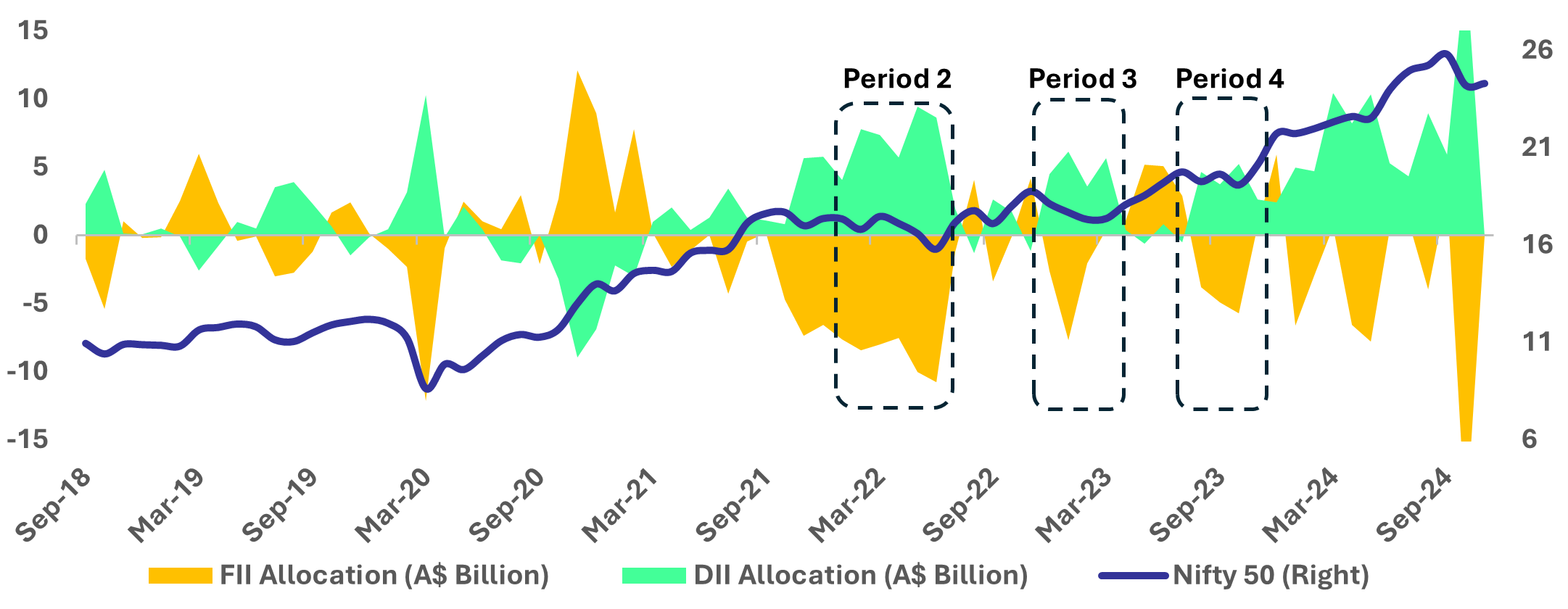Capitalising on India (Part I)
The Best Way to Invest in India
India, as the fourth-largest financial market and one of the world's fastest-growing economies, presents an undeniably compelling opportunity for investors. To fully capitalise on this growth story, it is essential to strategically invest in Indian stocks to maximise returns.
We propose that three critical factors can guide investors in achieving this objective effectively. In this note, we discuss the first of the key factors.
Stay Invested: Structural Over Tactical
To evaluate the performance of staying invested versus tactical trading in the Indian stock market, we analysed the contrasting approaches of the two primary investor groups: foreign and domestic investors.
Foreign investors, including Foreign Institutional Investors (FIIs) and Foreign Portfolio Investors (FPIs), have historically favoured a tactical approach over a structural one in India. This strategy has often led to missed opportunities in this high-growth market, as their activities primarily revolve around short-term tactical beta plays rather than long-term commitments to structural allocations. Typically, EM and Asia Funds (a large component of FII//FPI investors) tend to play India more tactically, switching between over and underweight.
In contrast, Domestic Institutional Investors (DIIs) in India have evolved into "rupee cost averaging" through monthly investment plans via their local mutual fund. In CY2024 alone, local investors invested over US$60bn, into their own market!
By studying the timing and impact of FII entries and exits and comparing their strategies with those of DIIs, we aim to highlight key differences. Using historical data on allocations and the performance of the Nifty 50 index, we assess how effectively FII strategies leverage—or stray from—market opportunities.
Nifty Performance vs FII and DII Net Allocation

Period Net Flows and Subsequent Performance
| Period | FII Allocation A$bn |
DII Allocation A$bn |
Subsequent 12m Performance |
1. Feb20 - Apr20 |
-15.5 | 13.3 | 69% |
| 2. Feb22 - Jun22 | -25.6 | 22.5 | 16% |
| 3. Dec22 - Apr23 | -9.4 | 15.4 | 34% |
| 4. Aug23 - Dec23 | -9.9 | 11.6 | 11% (YTD) |
Source: Motilal Oswal (Bulls & Bears), NSE, data as of 31/10/2024
FII's often reduce their exposure during market downturns, frequently missing out on the recovery gains that follow. In contrast, DIIs tend to increase their allocations during these periods, providing market stability. Historical data highlights that during significant market declines, DII inflows typically counterbalance FII outflows, with the Nifty 50 index often rebounding thereafter. However, FIIs commonly re-enter at higher market levels, reflecting suboptimal timing and forfeiting substantial gains from post-recovery rallies.
This pattern underscores the advantages of adopting a structural, long-term allocation strategy over a tactical rebalancing approach. A consistent investment strategy, akin to that of domestic investors, allows for better alignment with India's enduring growth trajectory and the potential for enhanced alpha generation. The compounding benefits of long-term investments play out across market cycles, rewarding those who stay invested. However, behavioural challenges often deter foreign investors from re-entering markets at higher levels after selling, further emphasising the need for a more disciplined, cycle-agnostic approach.
5 topics
1 stock mentioned

